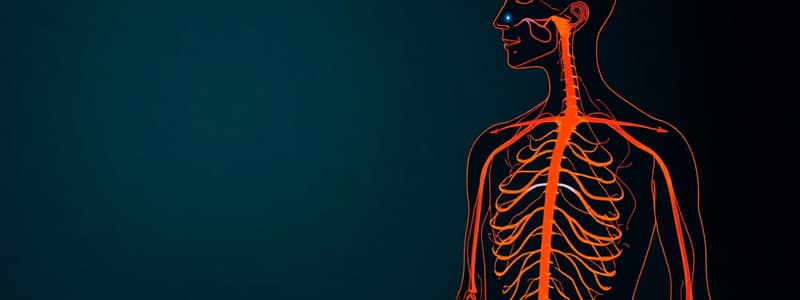Podcast
Questions and Answers
Which of the following statements about autonomic ganglia is false?
Which of the following statements about autonomic ganglia is false?
- They relay preganglionic fibers to postganglionic fibers.
- They consist solely of postganglionic fibers. (correct)
- They are located outside the central nervous system.
- They can be classified into lateral, collateral, and terminal types.
Which of the following pairs identifies a correct anatomical origin of the autonomic nervous system?
Which of the following pairs identifies a correct anatomical origin of the autonomic nervous system?
- Thoracic from cranial nuclei
- Sacral from lower lumbar segments
- Cranial from lumbar segments
- Cranio-sacral primarily involves cranial nuclei III, VII, IX, and X. (correct)
What is the primary neurotransmitter involved in the autonomic ganglia?
What is the primary neurotransmitter involved in the autonomic ganglia?
- Acetylcholine (correct)
- Dopamine
- Epinephrine
- Norepinephrine
How many relay connections occur in the autonomic ganglia during nerve impulse transmission?
How many relay connections occur in the autonomic ganglia during nerve impulse transmission?
Which type of autonomic ganglia is exclusively responsible for sympathetic relay?
Which type of autonomic ganglia is exclusively responsible for sympathetic relay?
What type of action occurs when the sympathetic nervous system stimulates the heart while the parasympathetic system inhibits it?
What type of action occurs when the sympathetic nervous system stimulates the heart while the parasympathetic system inhibits it?
Which of the following is an example of antagonistic action between the sympathetic and parasympathetic systems?
Which of the following is an example of antagonistic action between the sympathetic and parasympathetic systems?
Which statement best describes complementary action between the sympathetic and parasympathetic systems?
Which statement best describes complementary action between the sympathetic and parasympathetic systems?
In which scenario do both the sympathetic and parasympathetic systems produce the same action?
In which scenario do both the sympathetic and parasympathetic systems produce the same action?
Which organ receives single innervation solely by the sympathetic system?
Which organ receives single innervation solely by the sympathetic system?
Flashcards
Autonomic Nervous System (ANS)
Autonomic Nervous System (ANS)
The part of the nervous system controlling involuntary actions like heart rate, digestion, and gland secretions.
Preganglionic Fiber
Preganglionic Fiber
The axon of the first neuron in an autonomic pathway, connecting to the CNS.
Autonomic Ganglion
Autonomic Ganglion
A collection of nerve cell bodies outside the CNS where preganglionic and postganglionic fibers connect.
Sympathetic System
Sympathetic System
Signup and view all the flashcards
Parasympathetic System
Parasympathetic System
Signup and view all the flashcards
Reciprocal action (autonomic)
Reciprocal action (autonomic)
Signup and view all the flashcards
Antagonistic action (autonomic)
Antagonistic action (autonomic)
Signup and view all the flashcards
Complementary action (autonomic)
Complementary action (autonomic)
Signup and view all the flashcards
Similar action (autonomic)
Similar action (autonomic)
Signup and view all the flashcards
Single innervation (autonomic)
Single innervation (autonomic)
Signup and view all the flashcards
Study Notes
Autonomic Nervous System
- The autonomic nervous system (ANS) controls involuntary actions like cardiac muscle, smooth muscle, and glands
- It occupies both the peripheral nervous system (PNS) and central nervous system (CNS)
- The pathway from the CNS to an effector organ involves two neurons (except for the adrenal medulla)
- The first neuron, preganglionic fiber, is located in the CNS (e.g., cranial nerve nuclei or lateral horn of the spinal cord)
- The second neuron, postganglionic fiber, is within an autonomic ganglion and innervates the effector organ
ANS Divisions
- Anatomical divisions based on origin:
- Cranial: arises from cranial nerve nuclei (III, VII, IX, X)
- Thoracolumbar: arises from the lateral horn of the thoracic and upper lumbar spinal cord
- Sacral: arises from the lateral horn of the sacral spinal cord
- Physiological divisions based on function:
- Sympathetic system (thoracolumbar)
- Parasympathetic system (craniosacral)
Autonomic Ganglia
- Definition: Collections of nerve cells outside the CNS where preganglionic and postganglionic fibers communicate
- Types:
- Lateral (paravertebral): along the vertebral column
- Collateral (prevertebral): in front of the aorta
- Terminal: in the walls of organs
Properties of ANS
- One-way communication: Impulses travel in one direction within the ANS (preganglionic to postganglionic)
- One relay: Signals usually pass through one ganglion in the ANS
- One chemical transmitter (mostly acetylcholine (ACh) and norepinephrine (NE))
- Delay: due to chemical transmission at synapses
Autonomic Nervous System Actions
- Reciprocal action: When one system is stimulated, the other is inhibited within the same organ (e.g. heart)
- Antagonistic action: Opposite actions on different effector tissues within the same organ (e.g., iris)
- Complementary action: Actions working together; e.g., grief (sympathetic for energy, parasympathetic for crying)
- Same action: Some organs receive input from both systems leading to similar effects (e.g., salivary glands)
- Single innervation: Single system (sympathetic or parasympathetic) supplies certain organs, e.g., adrenal medulla, skin
Sympathetic System
- Originates from the thoracolumbar region of the spinal cord
- Preganglionic fibers are short, and postganglionic fibers are long
- Often described via "fight or flight" responses—increased heart rate, blood flow, respiration, etc.
Parasympathetic System
- Originates from Cranial nerves (III, VII, IX, X) and sacral spinal nerves
- Preganglionic fibers are long, and postganglionic fibers are short
- Often described via "rest and digest" responses—decreased heart rate, digestion, etc.
Neurotransmitters
- Acetylcholine (ACh): Released at all preganglionic neuron synapses, and by parasympathetic postganglionic neurons and in the adrenal medulla.
- Norepinephrine (NE): Released by sympathetic postganglionic neurons.
- Adrenaline/Epinephrine: released by Adrenal medulla
Studying That Suits You
Use AI to generate personalized quizzes and flashcards to suit your learning preferences.



